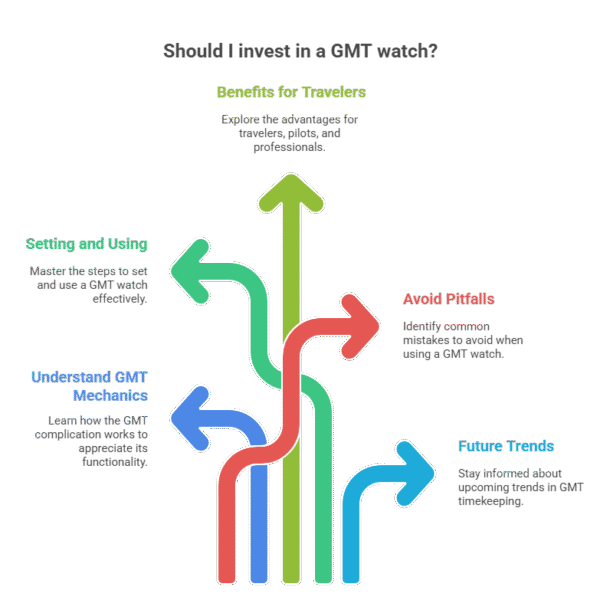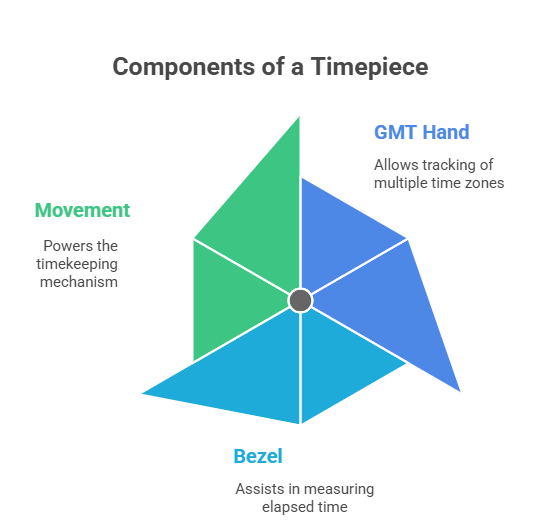What is a GMT Watch and How Does It Work?

A Guide To The GMT Watches and GMT Function

Why Travelers and Collectors Swear by GMT Watches
Ever missed a meeting because you miscalculated time zones? You’re not alone. Global business and travel make it tricky to juggle multiple time zones at once. That’s where GMT watches step in. A well-chosen GMT can save you from mental math, keep you punctual across borders, and even add serious style points to your wrist.
In this guide, you’ll learn:
What a GMT watch is (and why it matters now).
The mechanics behind the GMT complication.
How to set and use a GMT watch step by step.
The biggest benefits for travelers, pilots, and professionals.
Pitfalls to avoid and future trends shaping GMT timekeeping.
What is a GMT Watch?
A GMT watch is a timepiece that displays more than one time zone simultaneously. GMT stands for Greenwich Mean Time, the historical “zero point” for world timekeeping. Unlike a standard three-hand watch (hours, minutes, seconds), a GMT adds a fourth hand—the GMT hand—that circles the dial once every 24 hours.
Why it matters: in today’s global economy, professionals, travelers, and collectors want a reliable way to track local and “home” time at a glance.
How Does a GMT Watch Work?

The magic lies in the GMT hand and 24-hour bezel.
GMT Hand: Points to the 24-hour scale, showing a second time zone.
Bezel: Rotatable on most GMT watches, letting you add or subtract hours for a third time zone.
Movement: Mechanical or quartz, with a complication that synchronizes the extra hand.
So, you can keep track of “where you are” and “where you’re from”—and, with a quick bezel adjustment, “where you’re headed.”
Types of GMT Watches
Not all GMTs are built the same. Here are the main variations:
Caller GMT
The GMT hand is set independently, while the main hour hand stays fixed.
Best for desk workers coordinating calls with global teams.
True (or Traveler’s) GMT
The local hour hand adjusts independently, while the GMT hand stays synced to “home” time.
Perfect for frequent flyers changing time zones often.
Quartz GMT
Affordable, reliable, and low-maintenance.
Lacks the charm (and collectability) of mechanical movements.
Traditional vs Modern GMTs
Manual workarounds—like carrying two watches or converting time zones on your phone—are clunky. A GMT simplifies everything.
Speed: Switch time zones instantly with a bezel twist or crown adjustment.
Precision: Mechanical GMTs track multiple zones to the minute.
Style: From Rolex to Seiko, GMTs blend utility with aesthetics.
Benefits of Owning a GMT Watch
Why add one to your collection?
Global Awareness: Track home and destination time at a glance.
Professional Edge: Never miscalculate when scheduling international calls.
Travel Ease: Instantly reset to local time without losing track of “home.”
Collectible Value: GMTs are iconic in horology (think Rolex GMT-Master II, introduced for Pan-Am pilots).
Versatility: Sporty or dressy, GMTs fit most lifestyles.
How to Use a GMT Watch (Step-by-Step)
Step 1. Set local time
Pull the crown and align the hour/minute hands to your current location.
Step 2. Set home (GMT) time
Adjust the GMT hand to your “home” or reference city.
Step 3. Use the bezel for a third zone (optional)
Rotate bezel +/– hours to instantly track another region.
Step 4. Lock and check
Push the crown back in, confirm both times align, and you’re set.
Pro tip: Many pilots set GMT to UTC (Coordinated Universal Time), then rotate the bezel to track their flight destination.
Who Benefits Most from GMT Watches?
Frequent Flyers: Stay synced with home base while adapting to new zones.
Pilots & Crew: Aviation relies on universal time (UTC). A GMT is more than convenience—it’s standard practice.
Global Business Pros: Keep track of partners in London, Tokyo, or Dubai with zero confusion.
Collectors & Enthusiasts: GMTs hold legendary status (Rolex Pepsi, Tudor Black Bay GMT, Omega Planet Ocean).
Measuring the Value of a GMT Watch
How do you know a GMT is worth it?
Utility KPIs: Missed meetings avoided, smoother scheduling, time saved.
Durability: Longevity of movement, service intervals, resale value.
ROI for Collectors: Limited editions and iconic models often appreciate in value.
Common Challenges (and Fixes)
Complexity: First-time users find GMT setup confusing.
Fix: Follow the 4-step setup checklist above.
Cost: True GMTs from Swiss brands can run into thousands.
Fix: Explore microbrands or Japanese makers like Seiko and Citizen for value.
Maintenance: Mechanical GMTs require periodic servicing.
Fix: Budget service costs when investing.
The Future of GMT Watches
GMTs are evolving with modern needs:
Smart GMT Hybrids: Mechanical watches paired with smartwatch apps.
More Accessible Models: Affordable “true GMT” calibers from brands like Seiko and Miyota.
Sustainability: Eco-drive and solar-powered GMTs reducing reliance on battery swaps.
Expect the GMT complication to remain a favorite—blending tradition, utility, and evolving innovation.
Final Thoughts: Should You Buy a GMT Watch?
If you live, work, or travel across time zones, a GMT is more than a luxury—it’s a practical upgrade. It delivers convenience, confidence, and timeless style.
